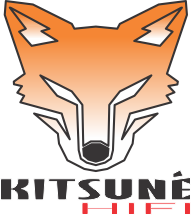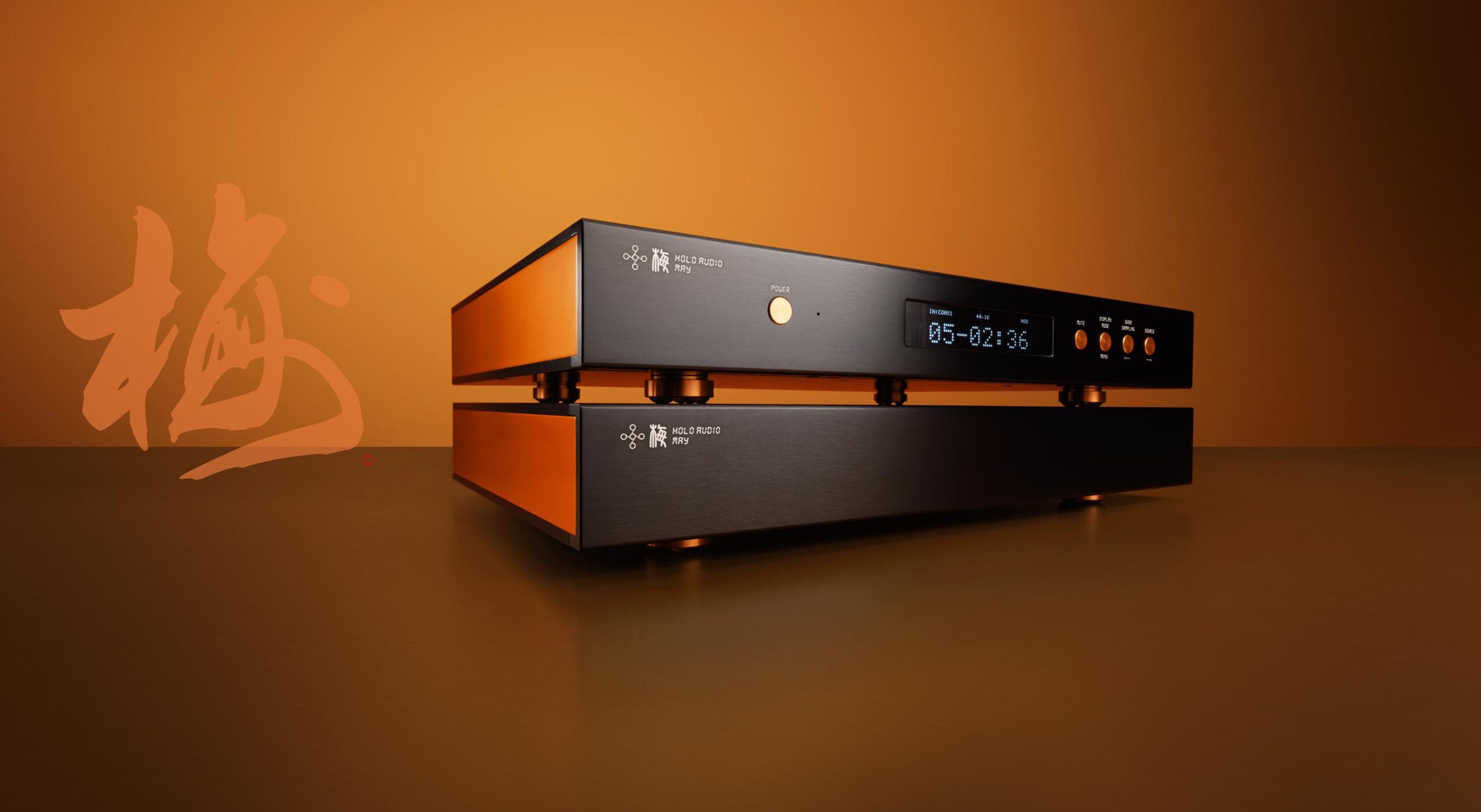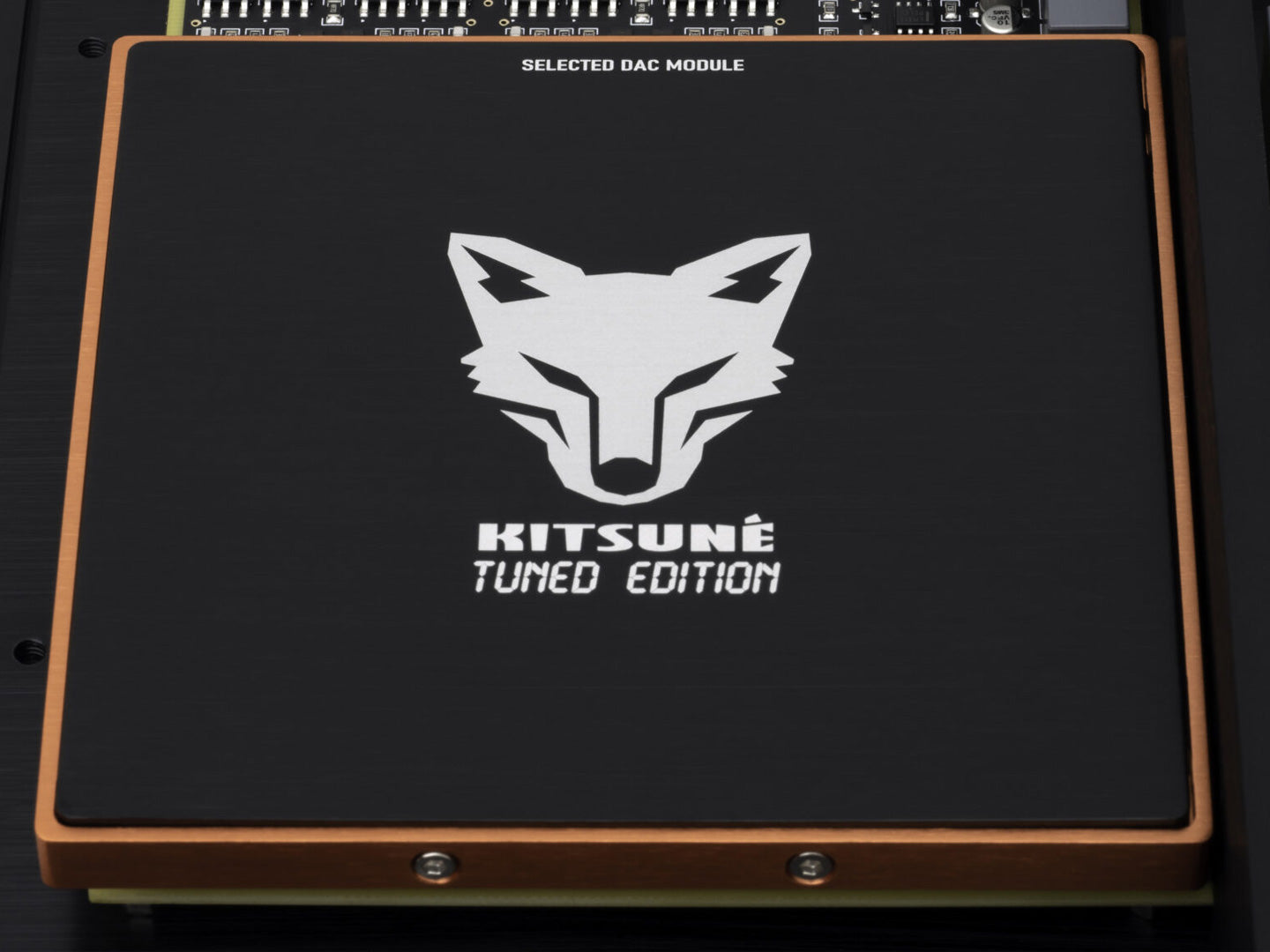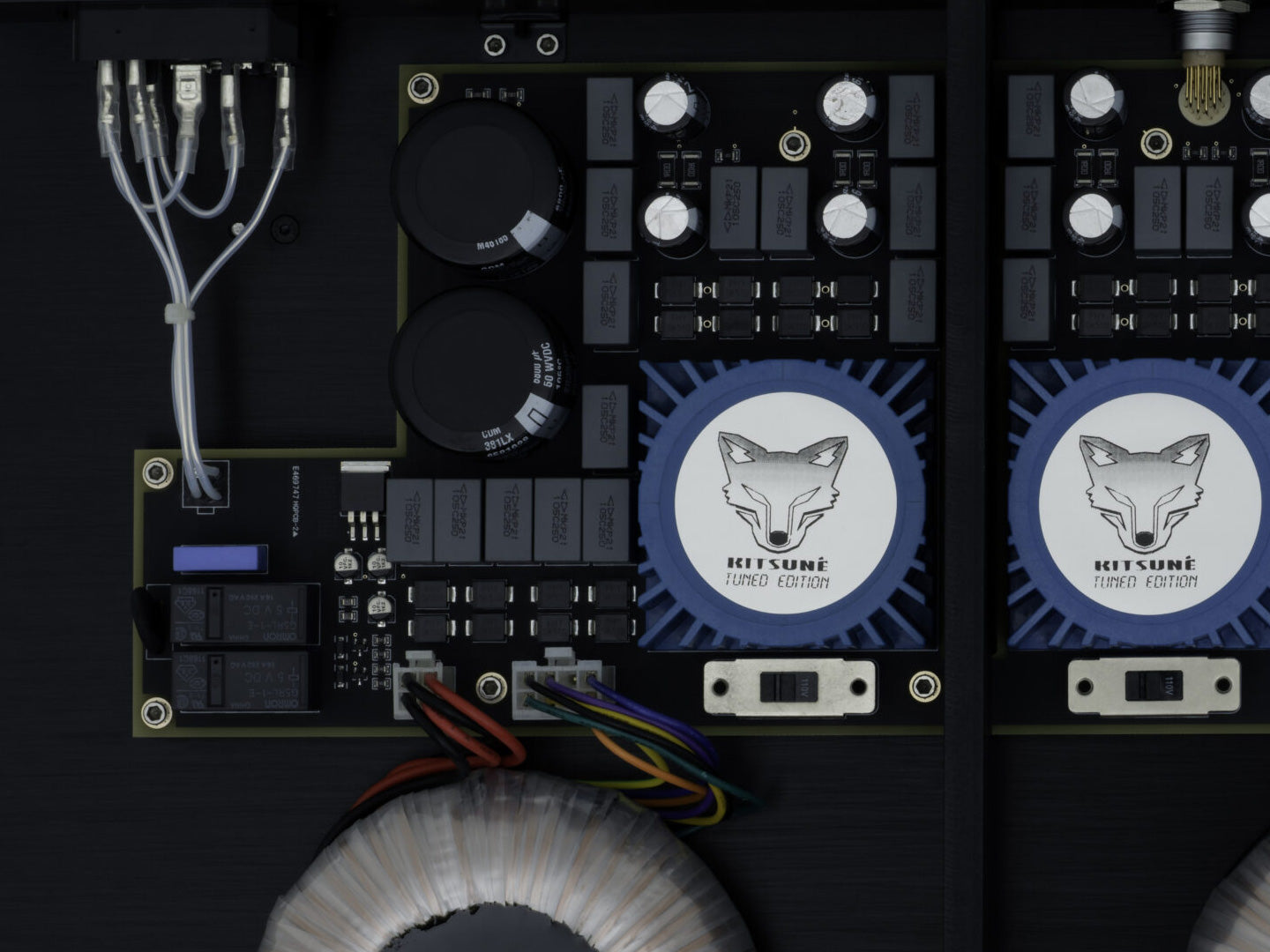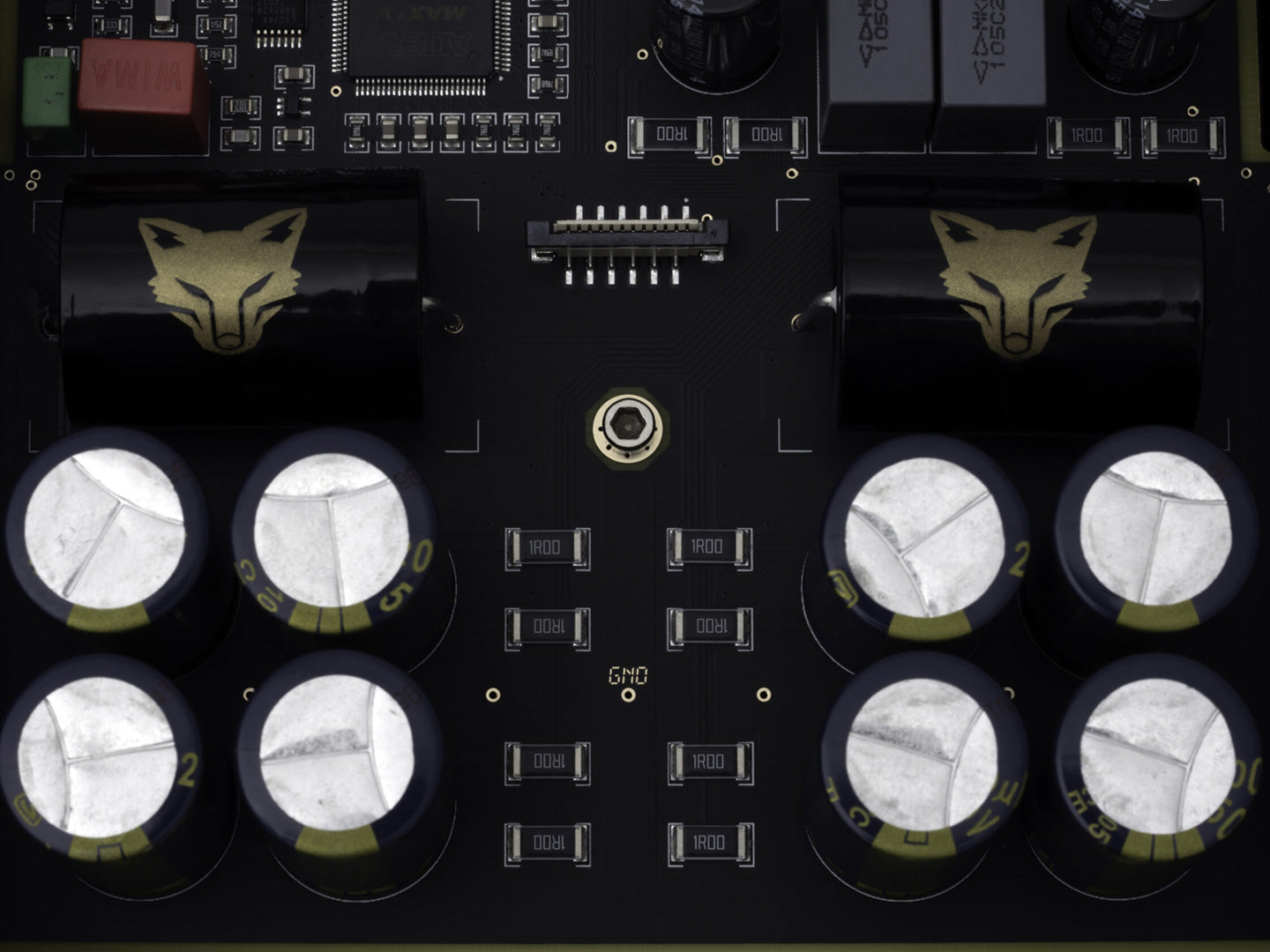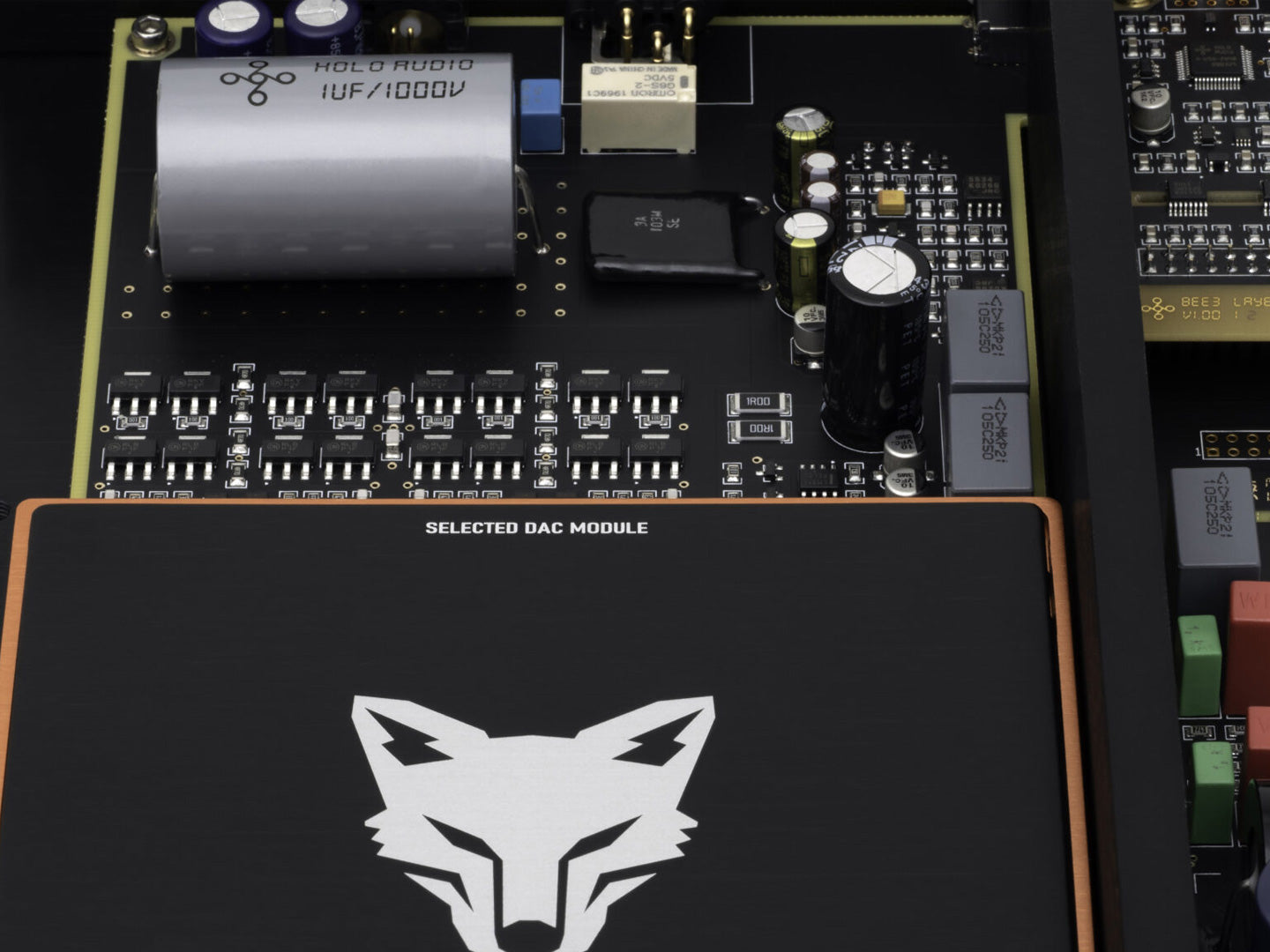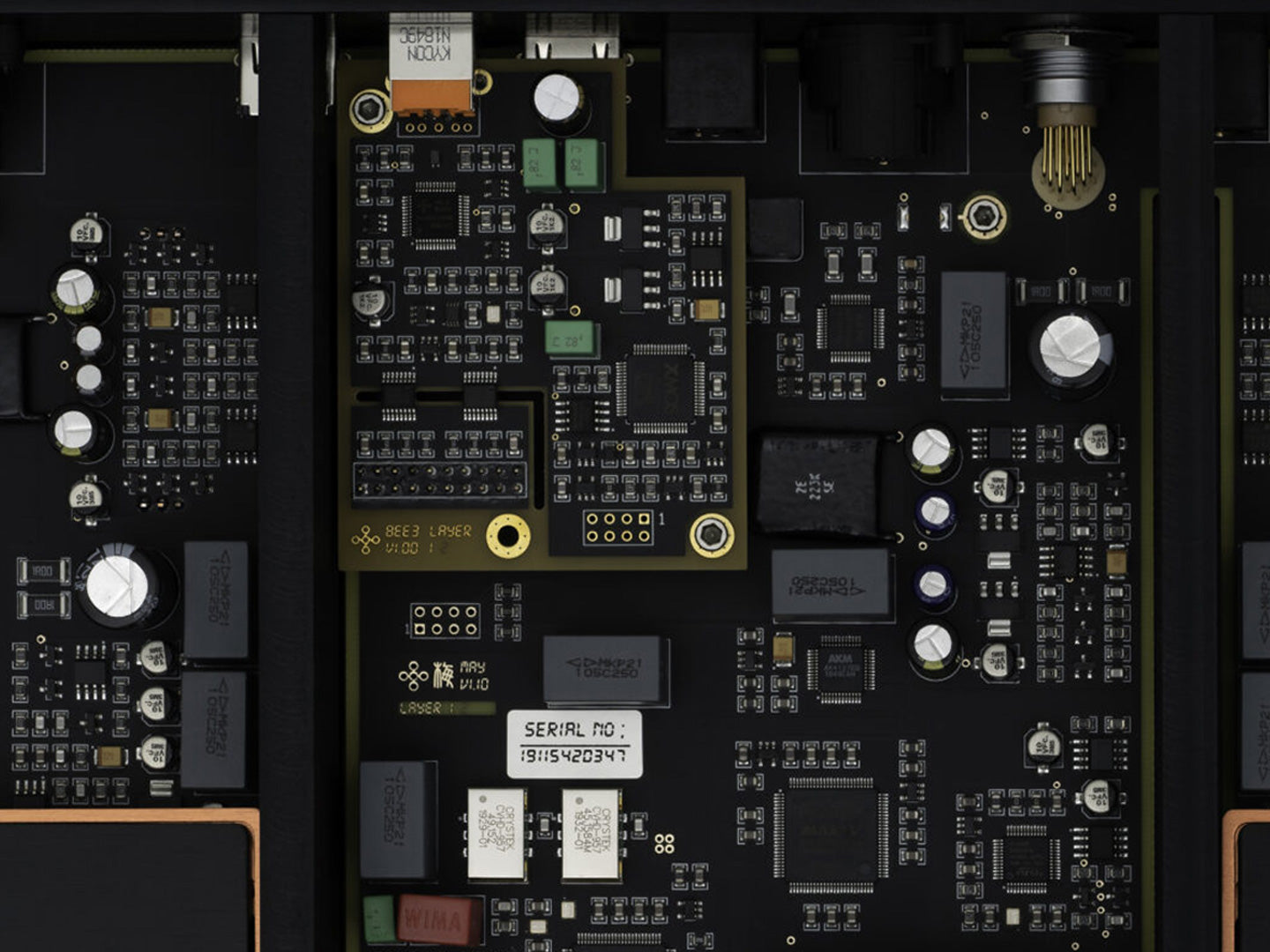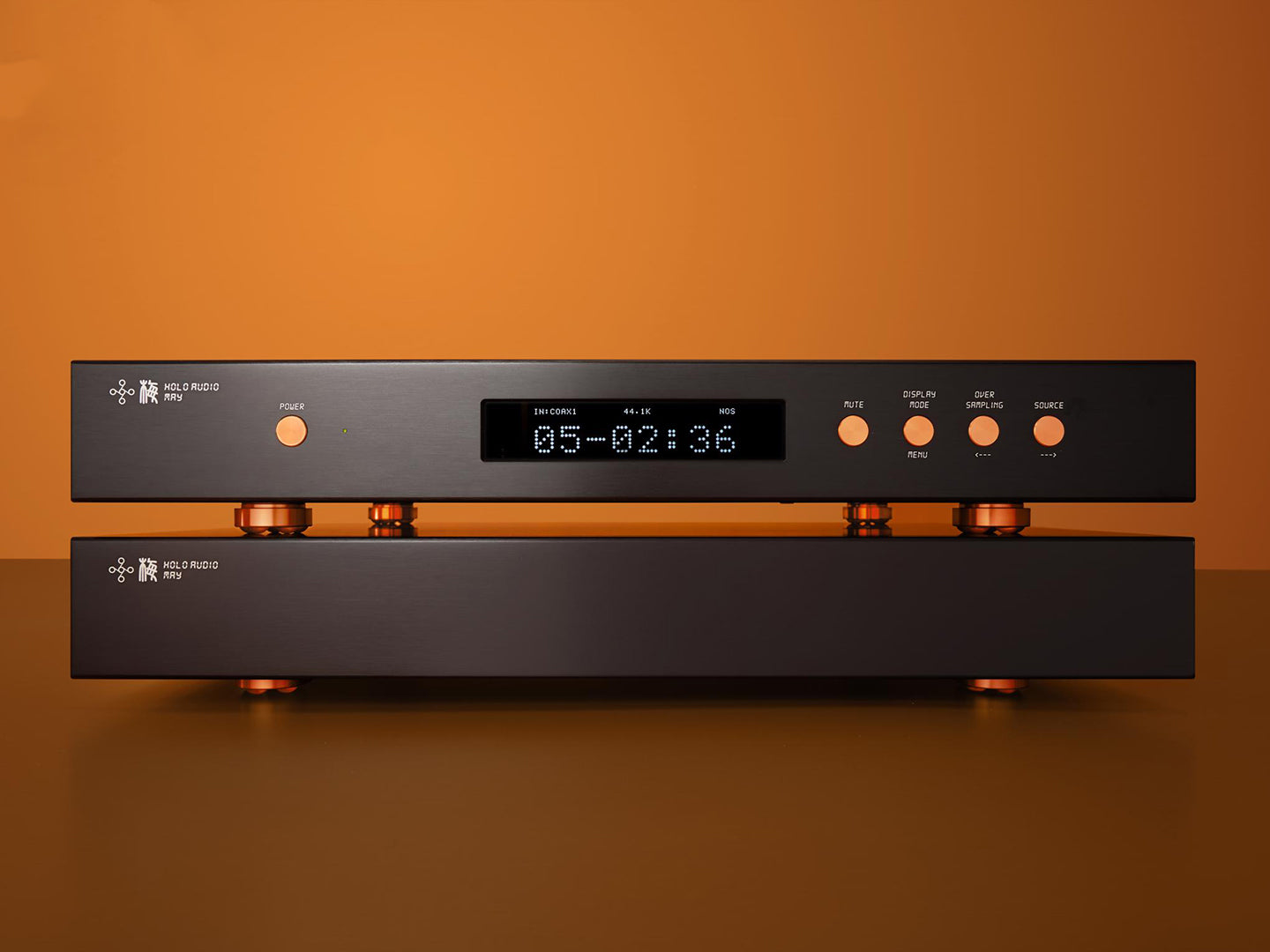
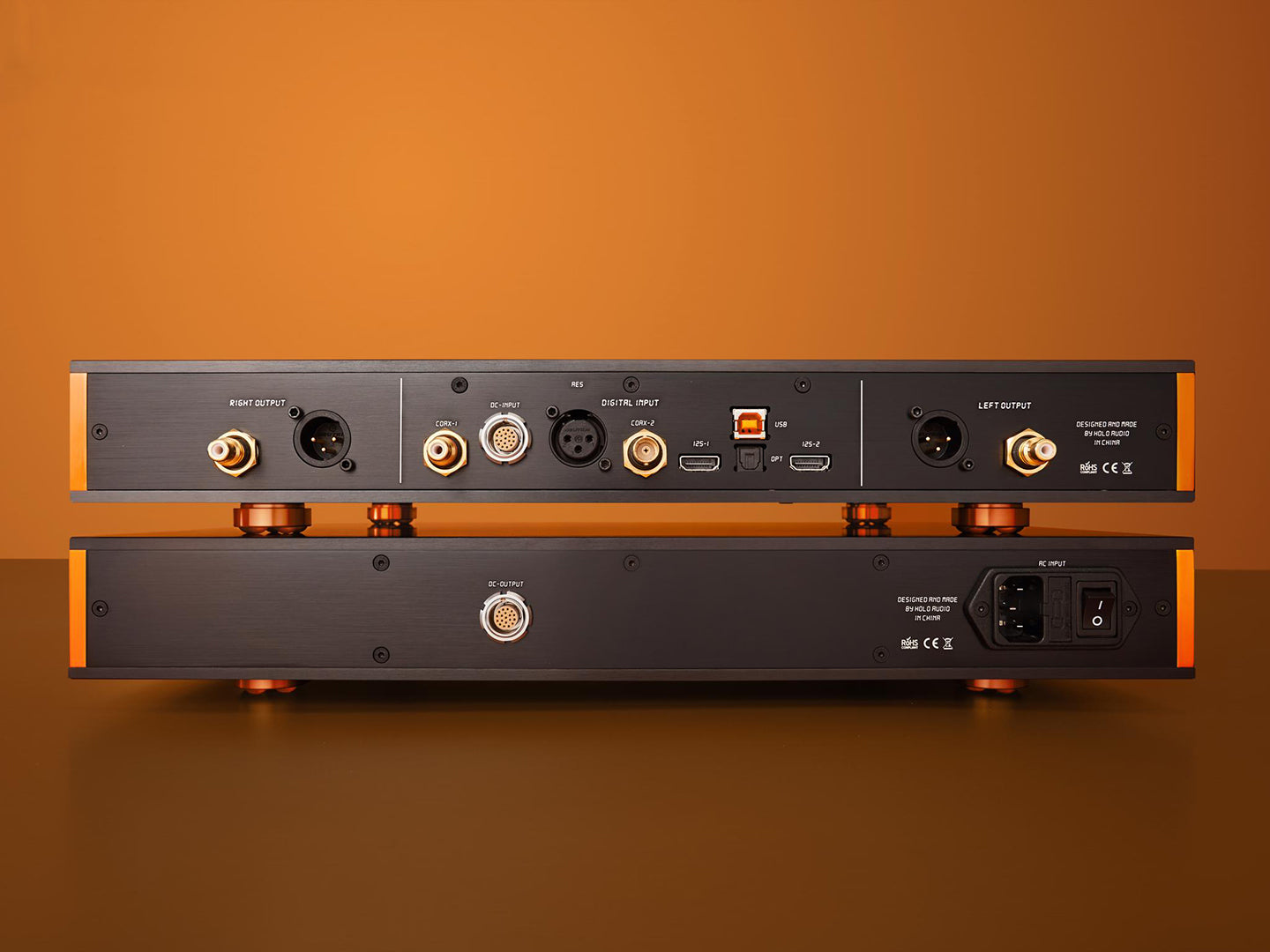
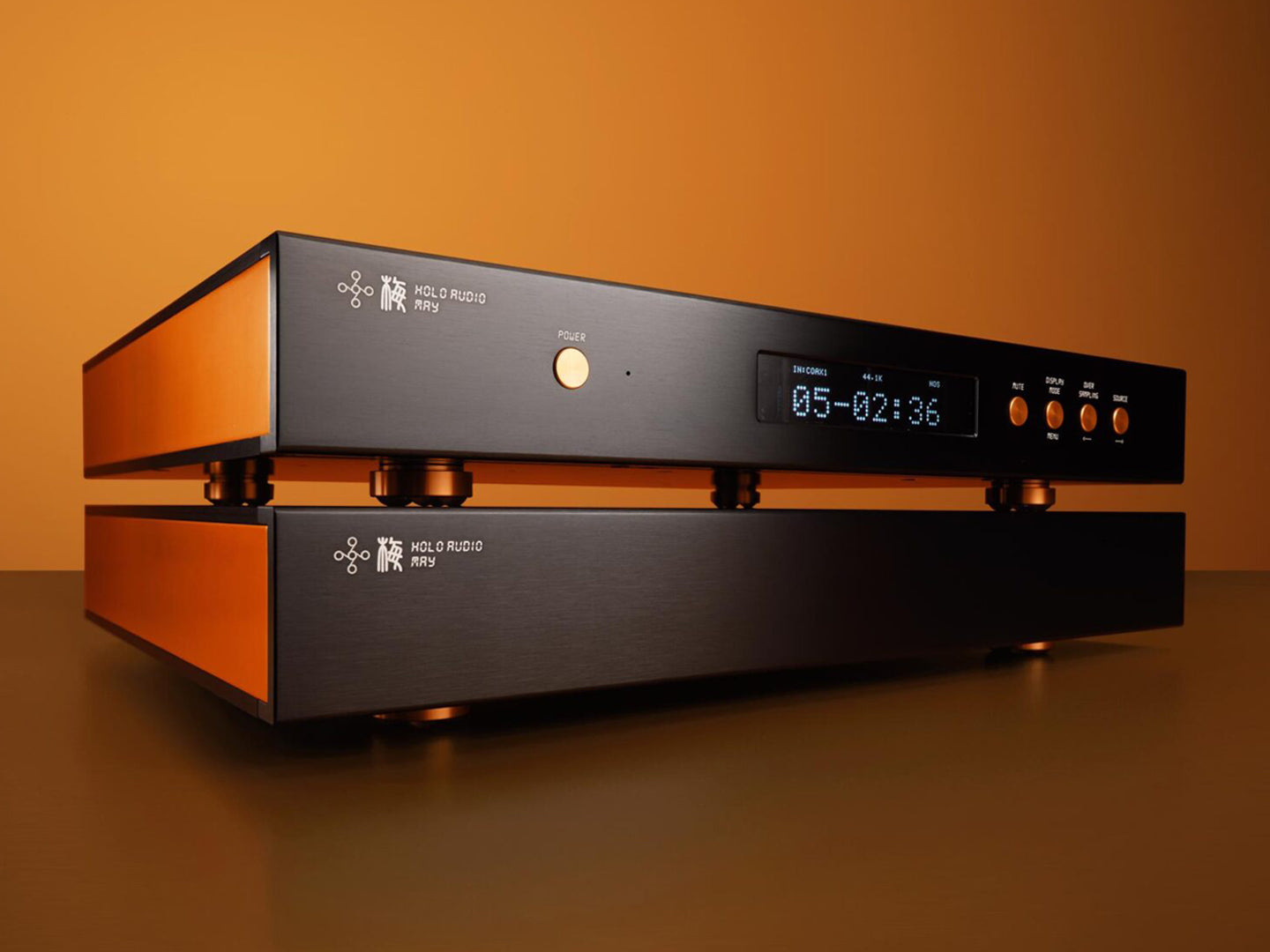
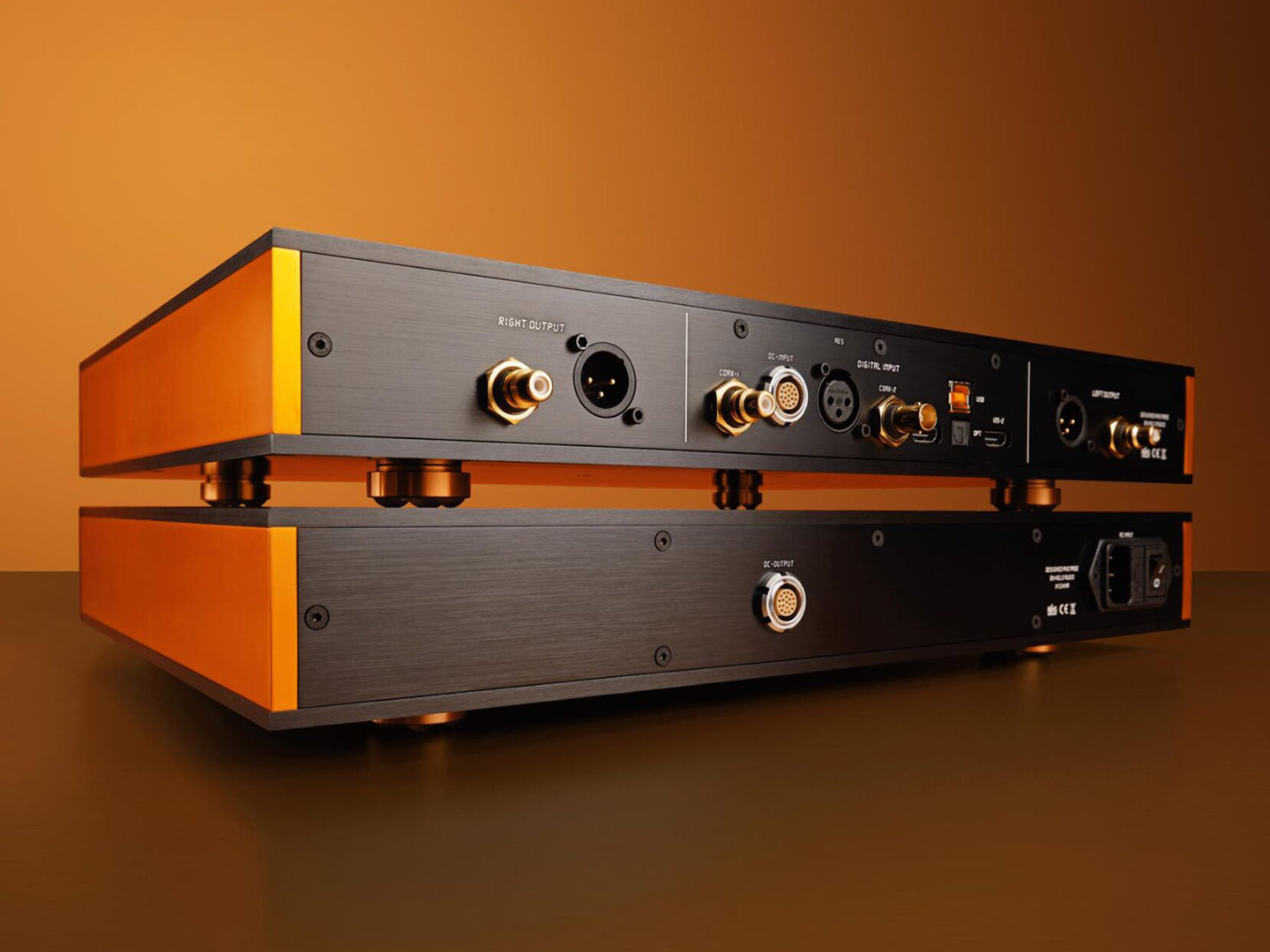
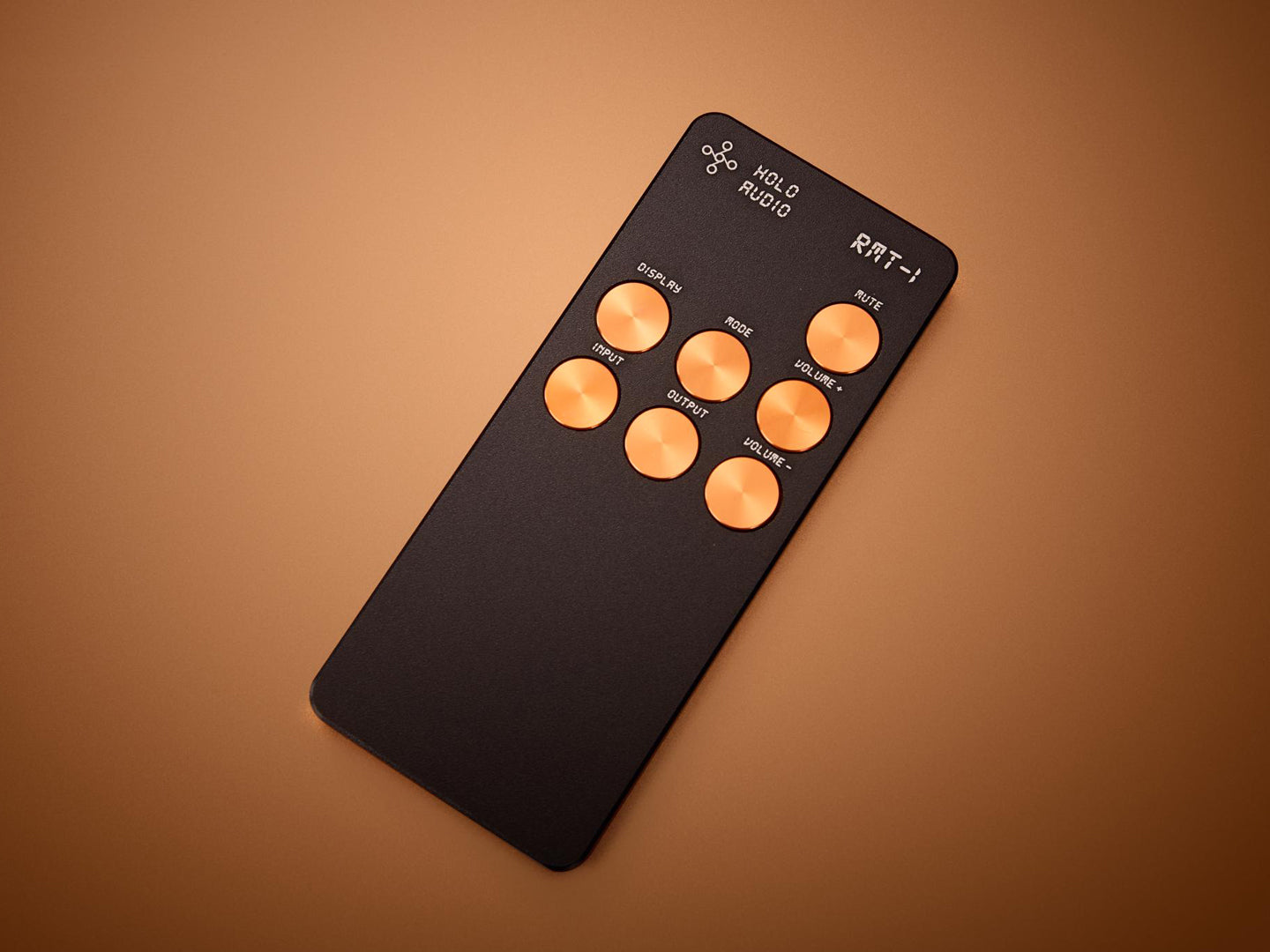
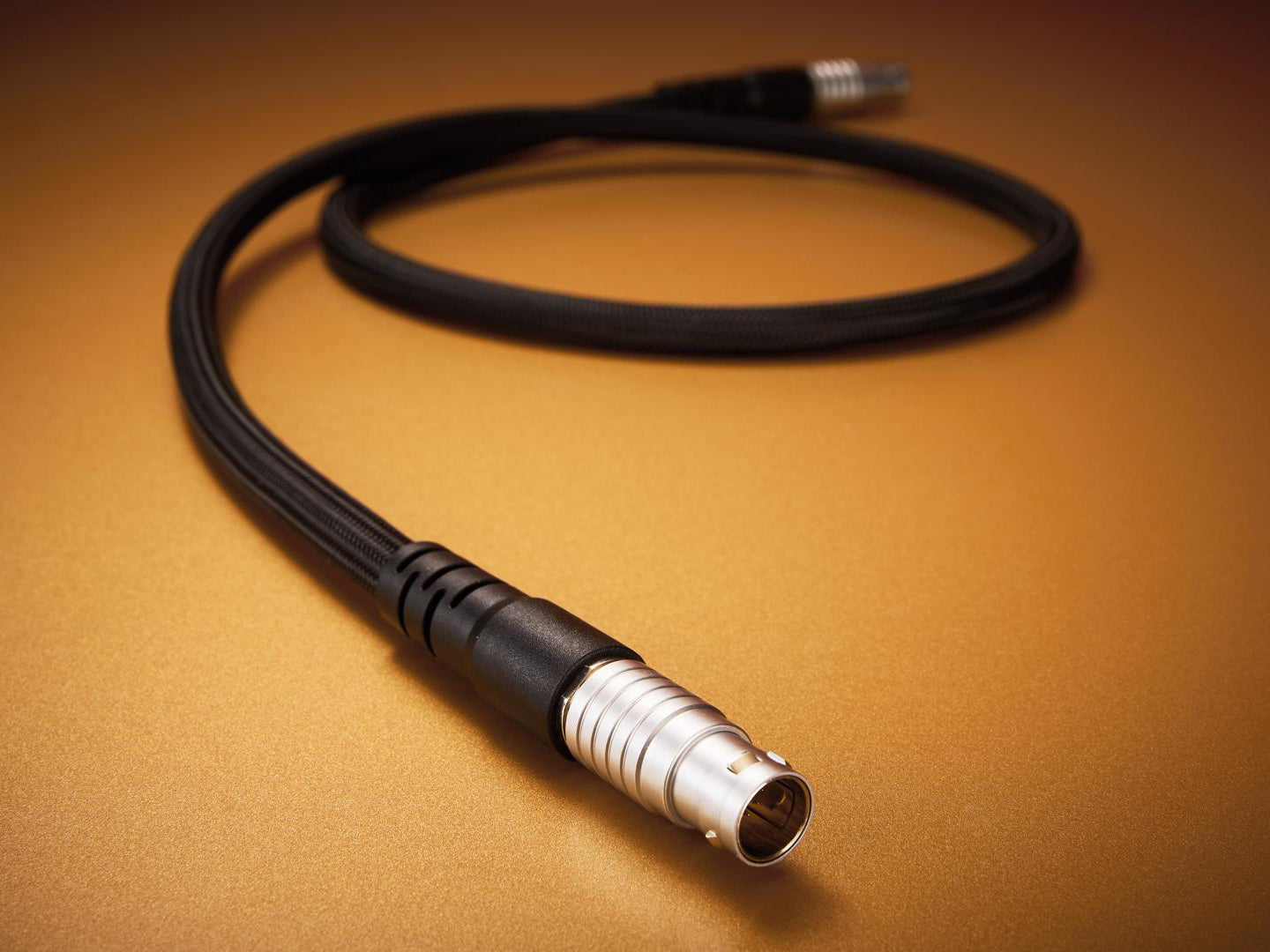
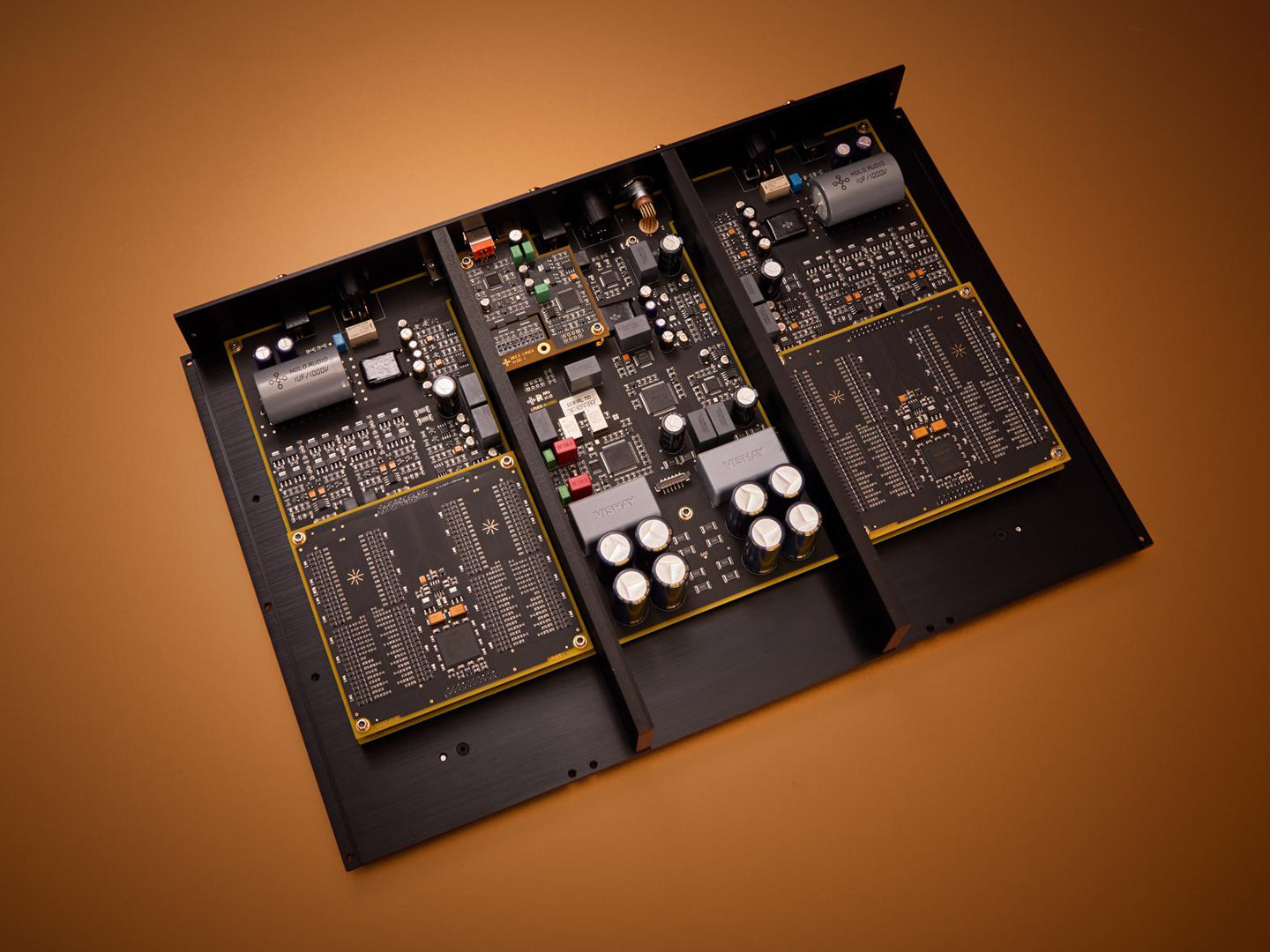
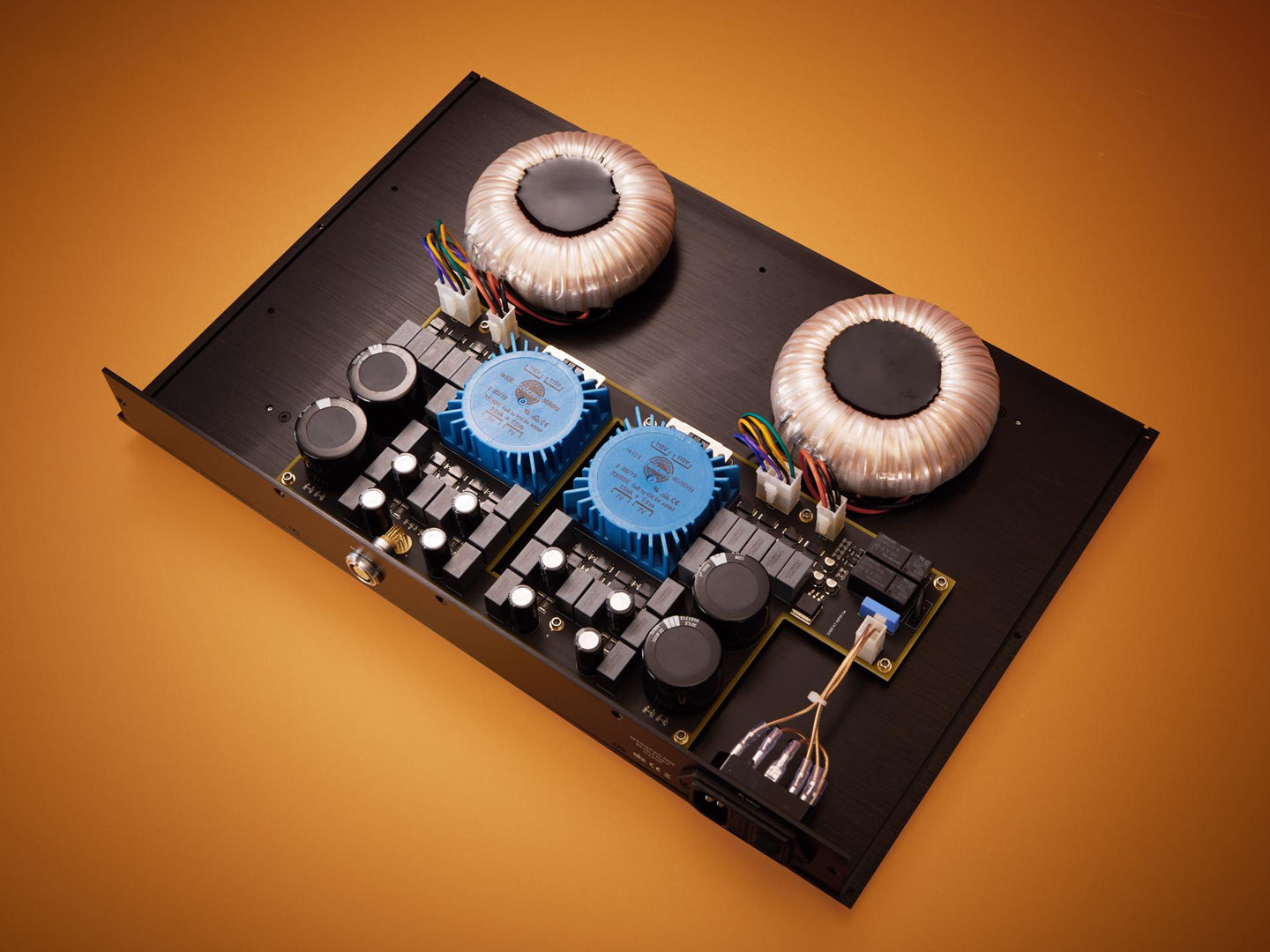
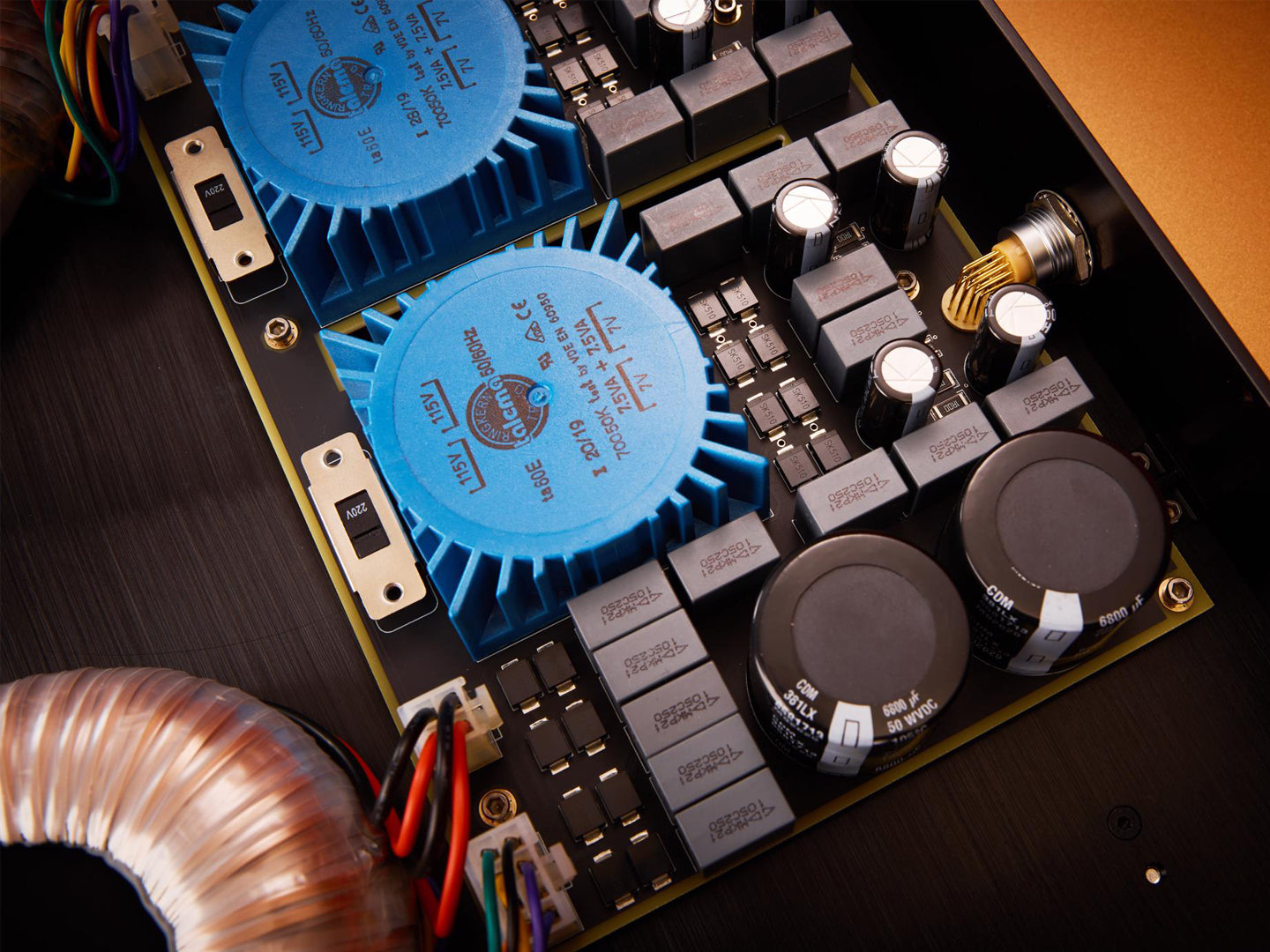
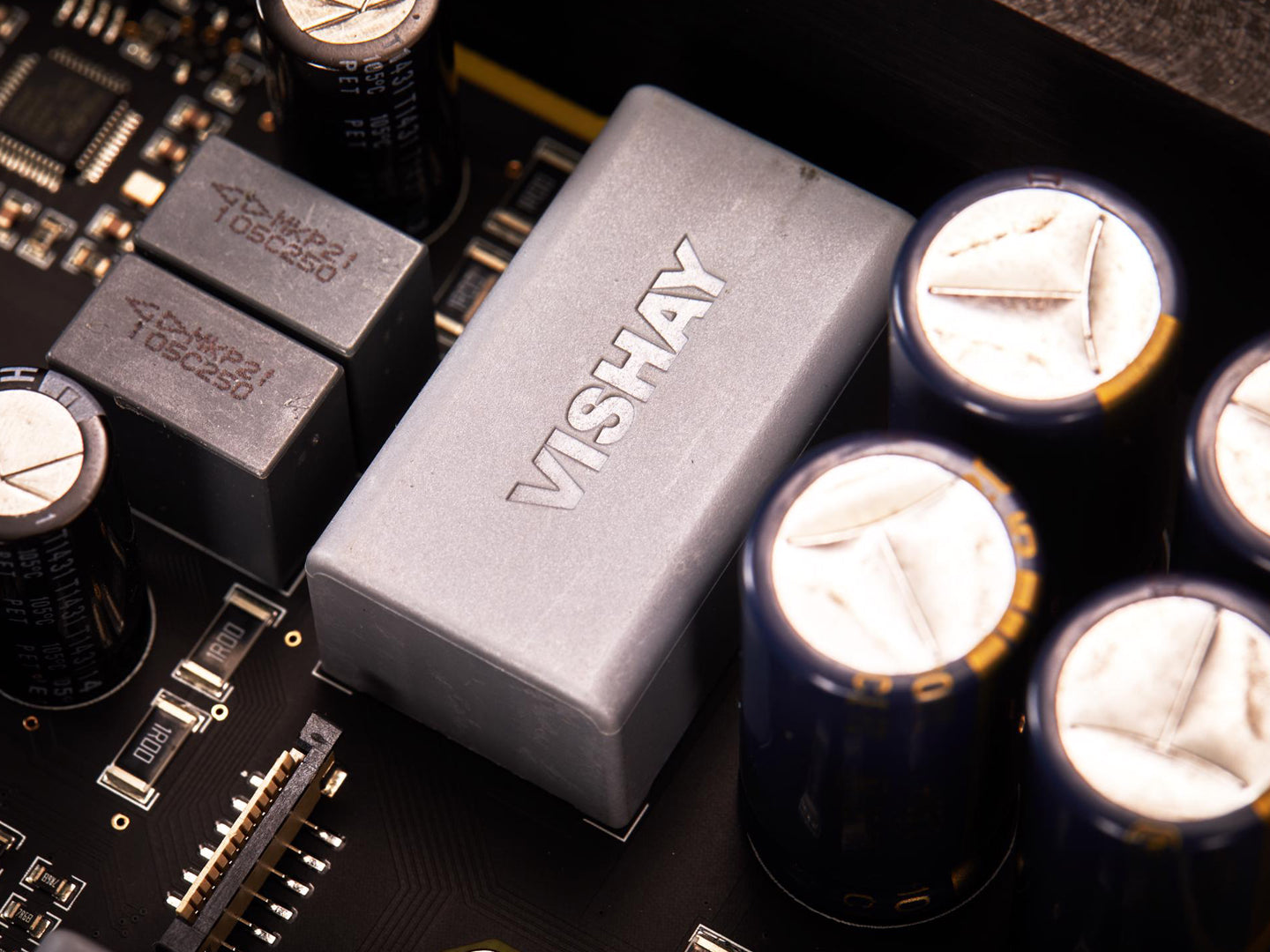

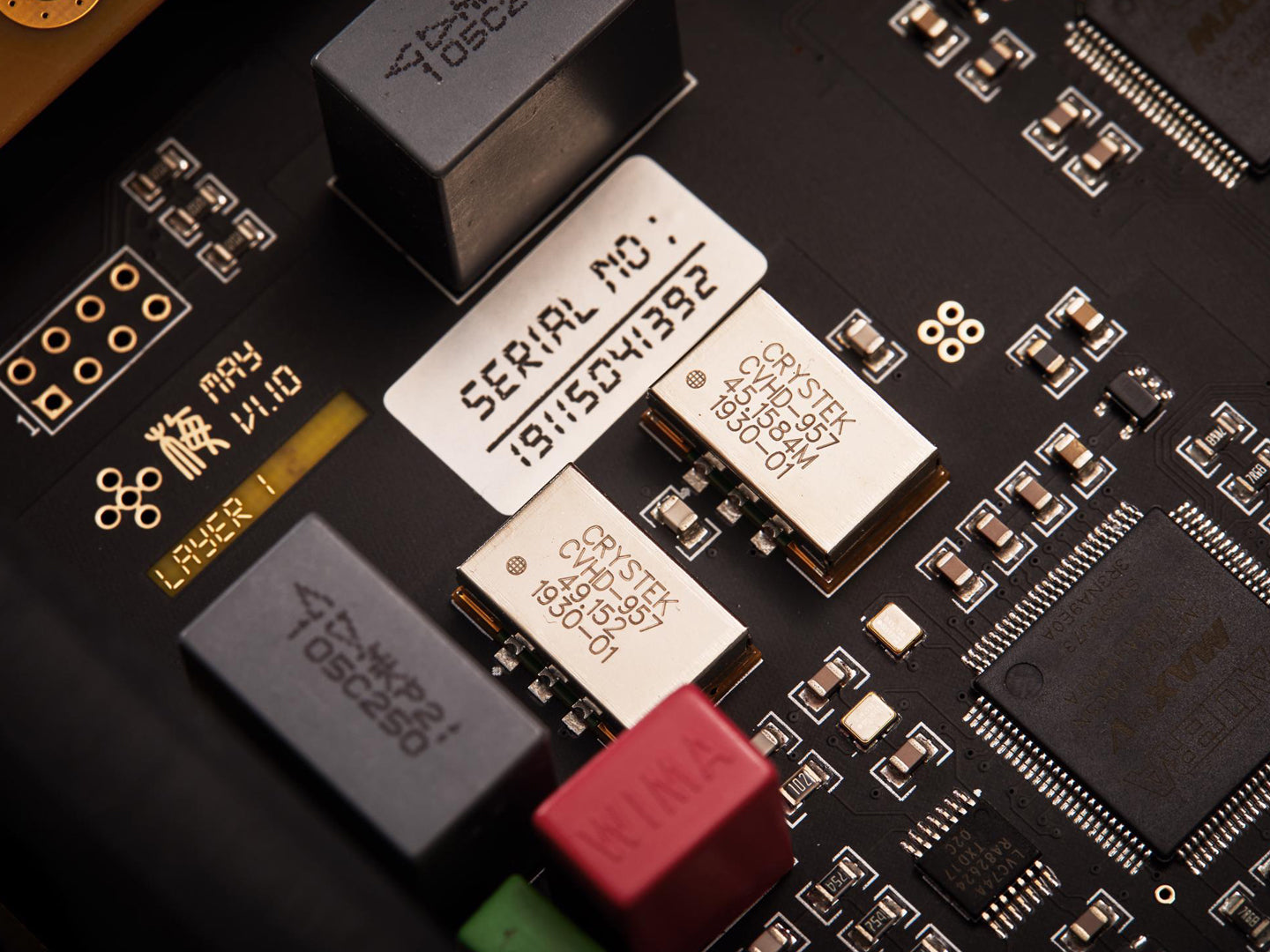
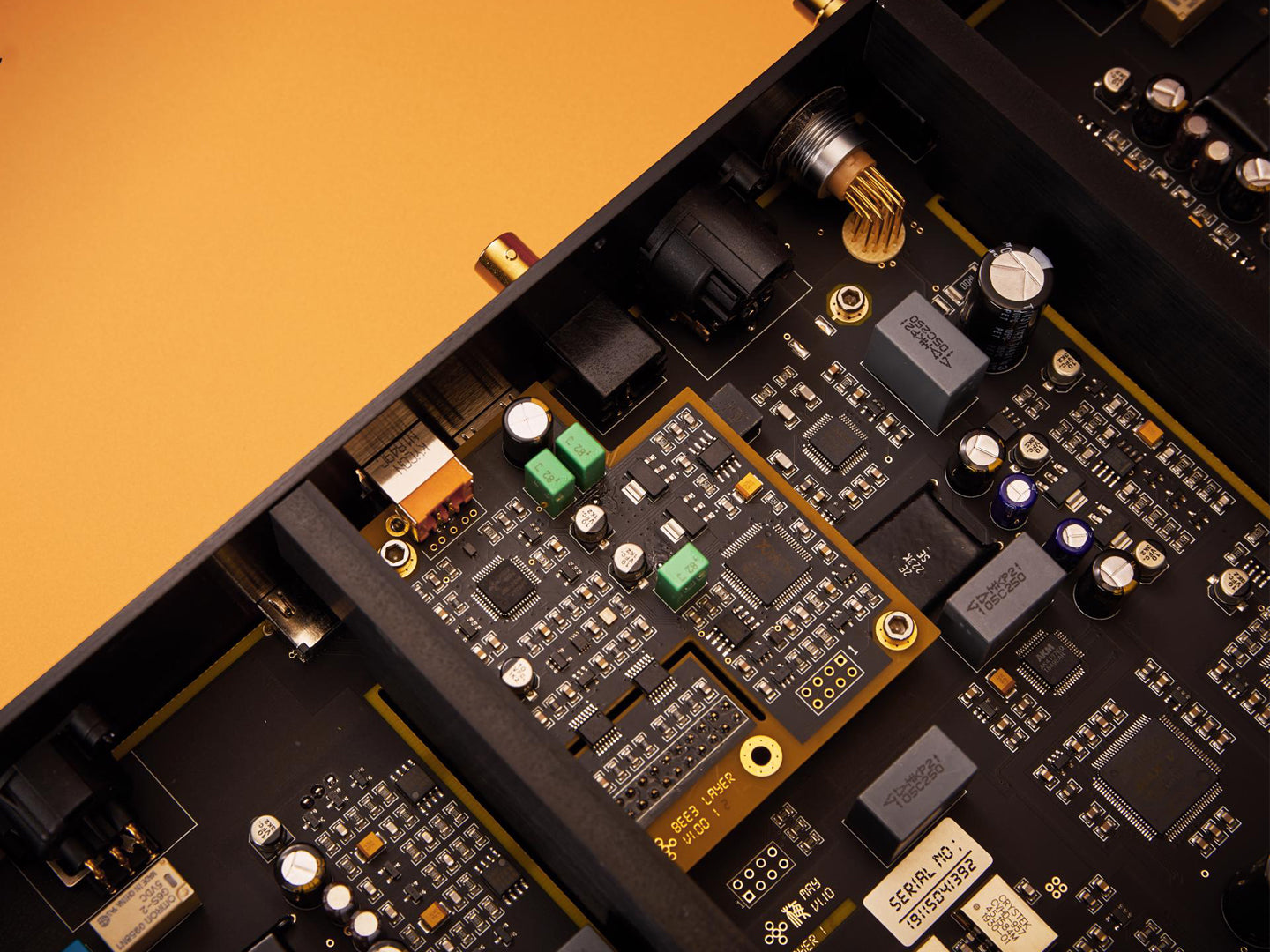
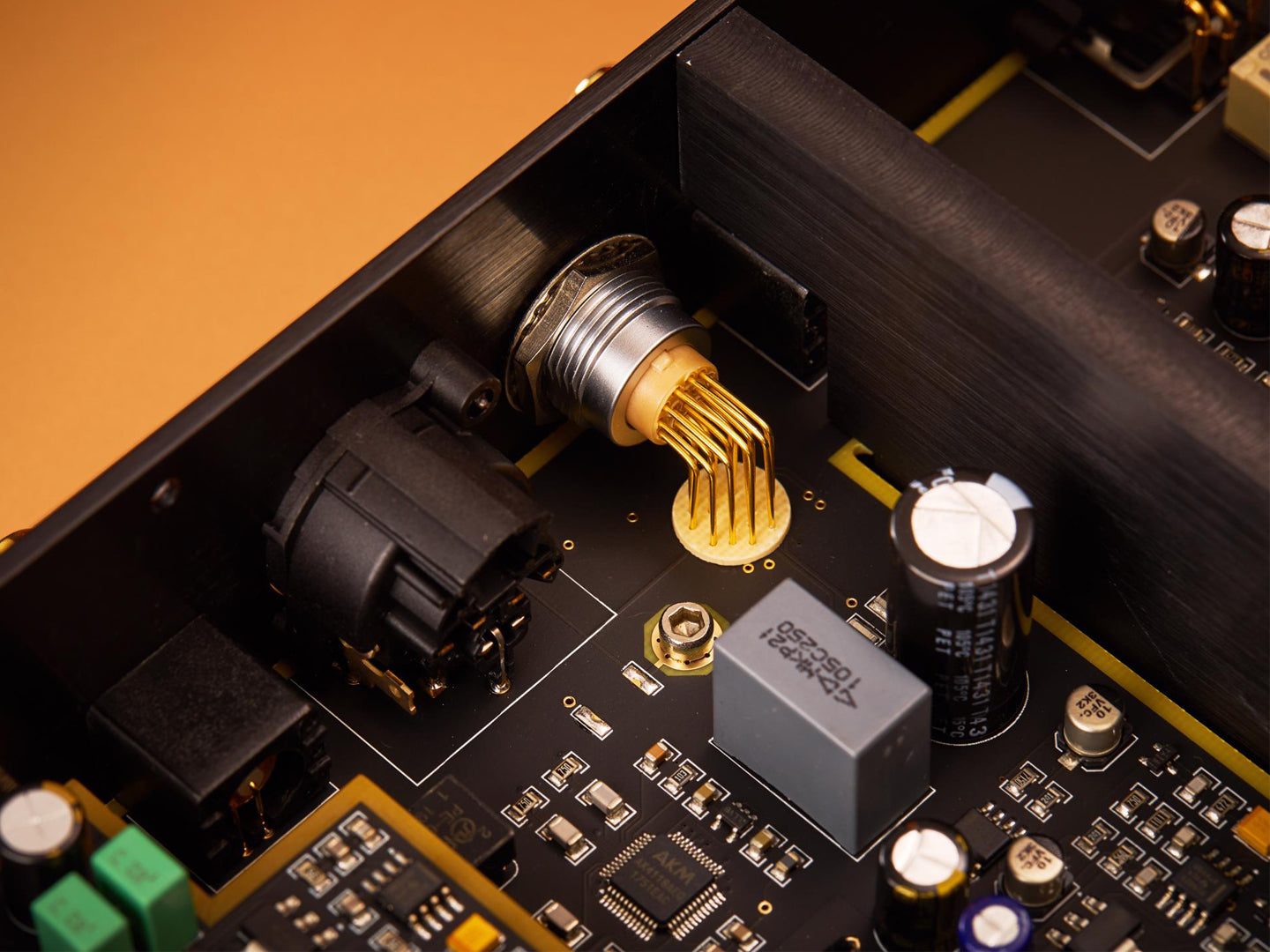
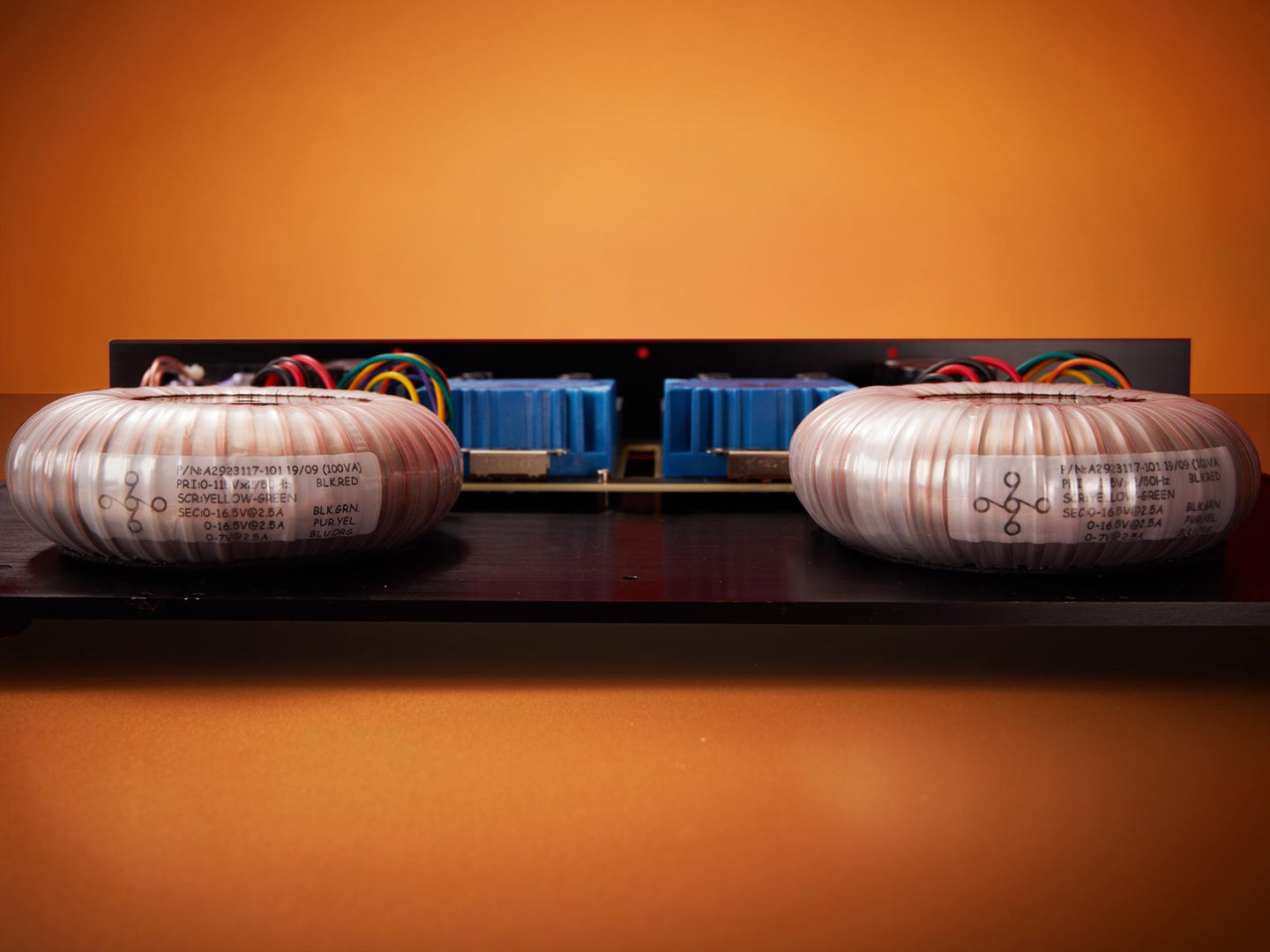
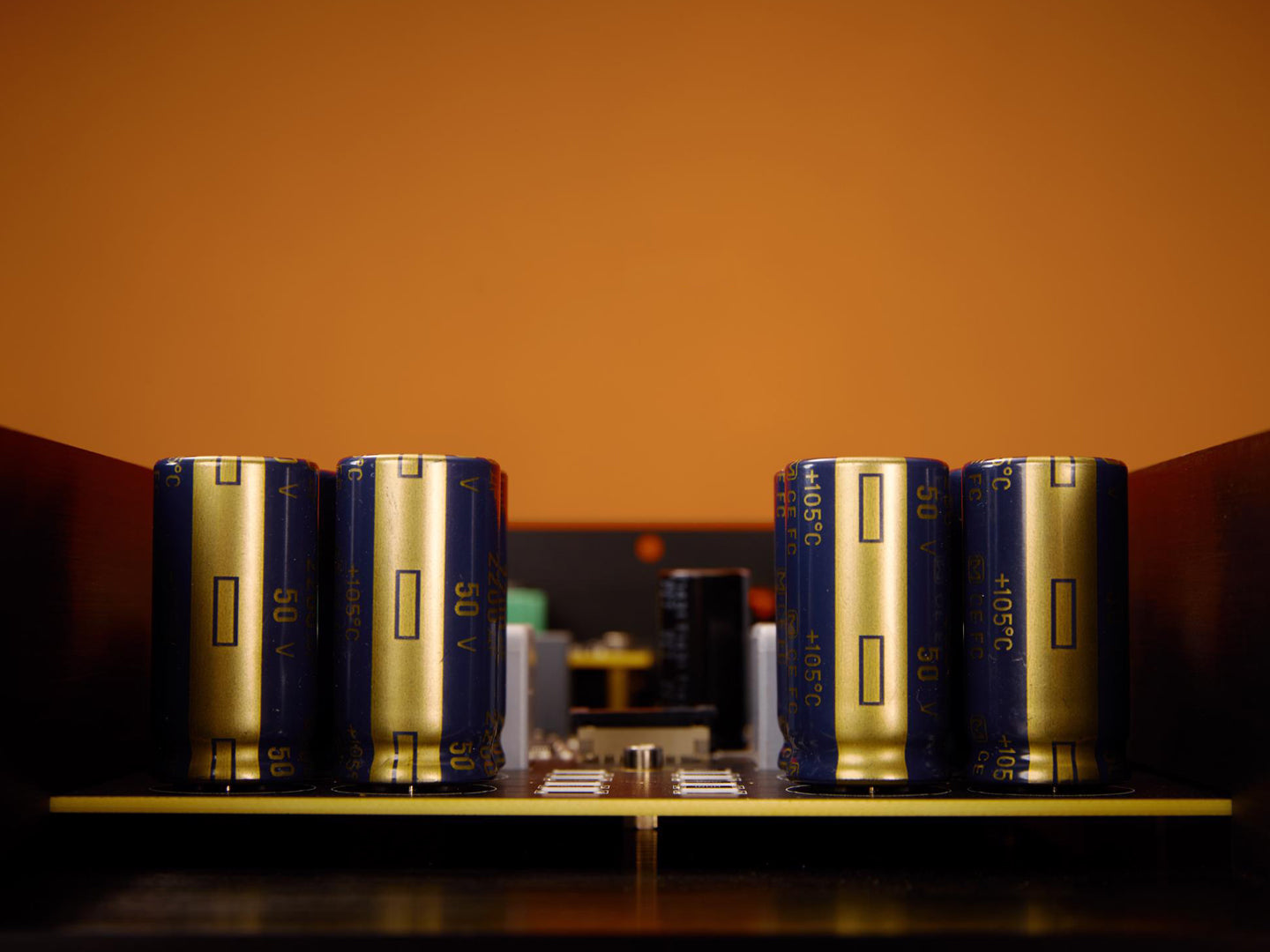
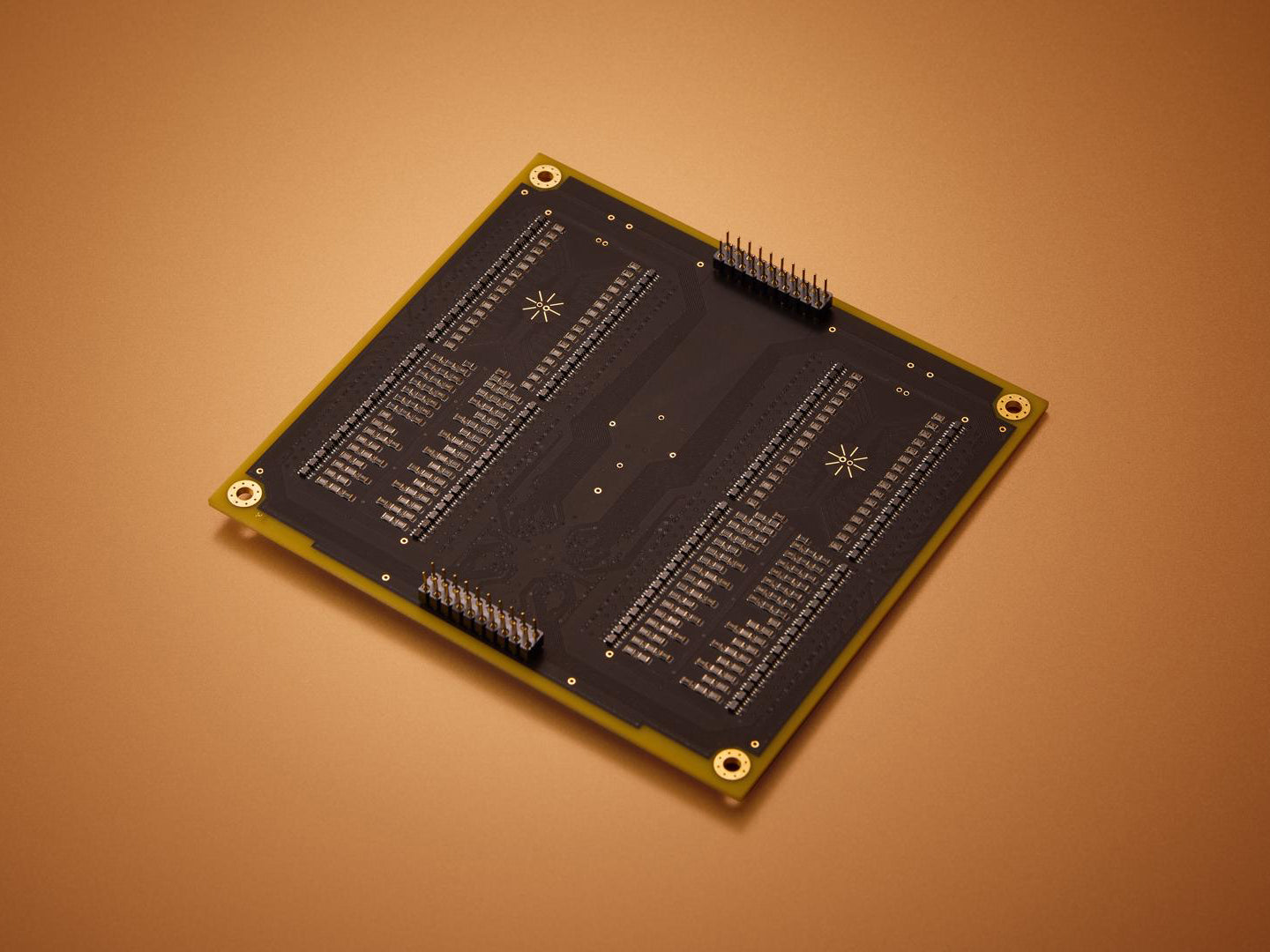
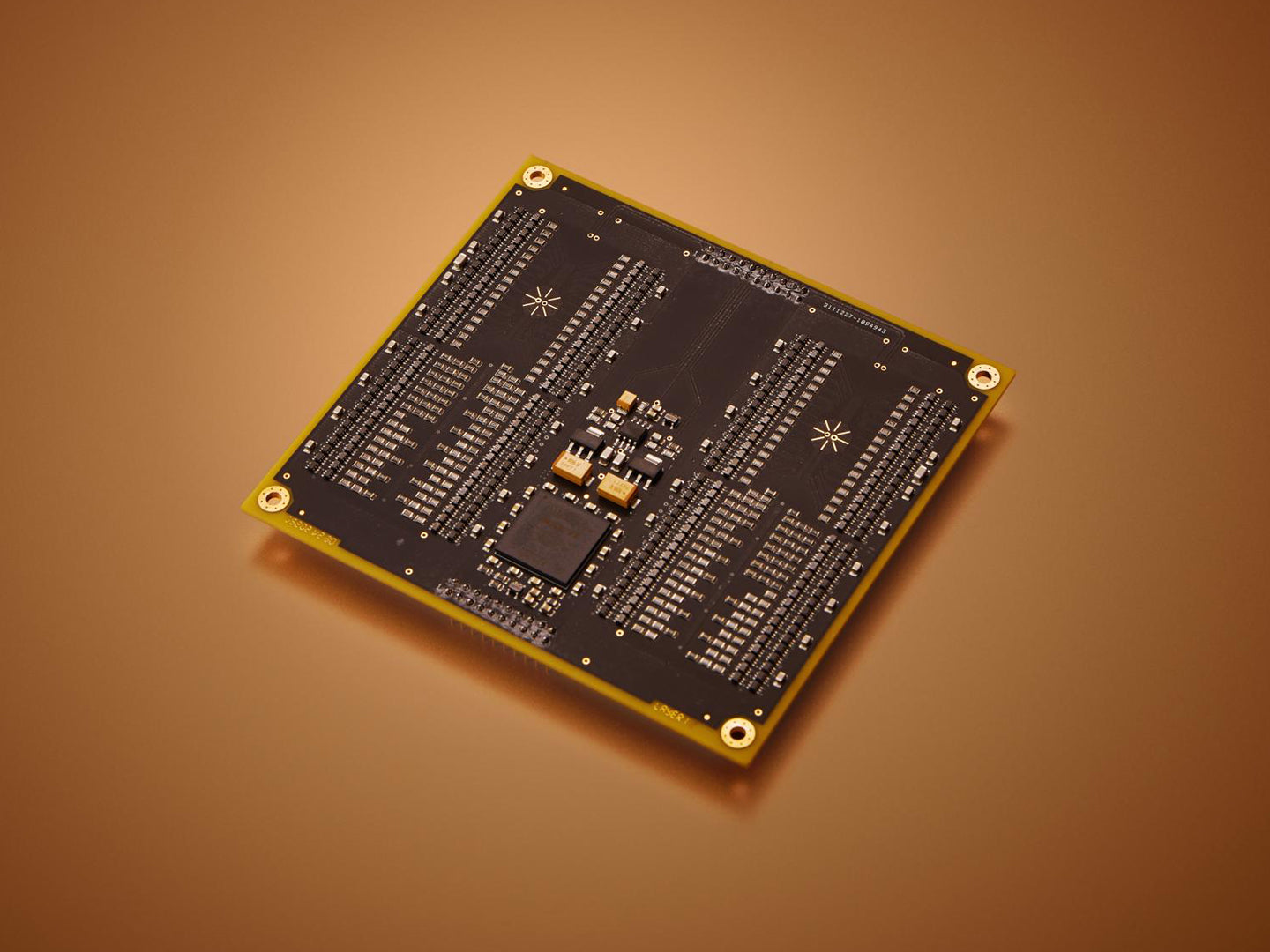
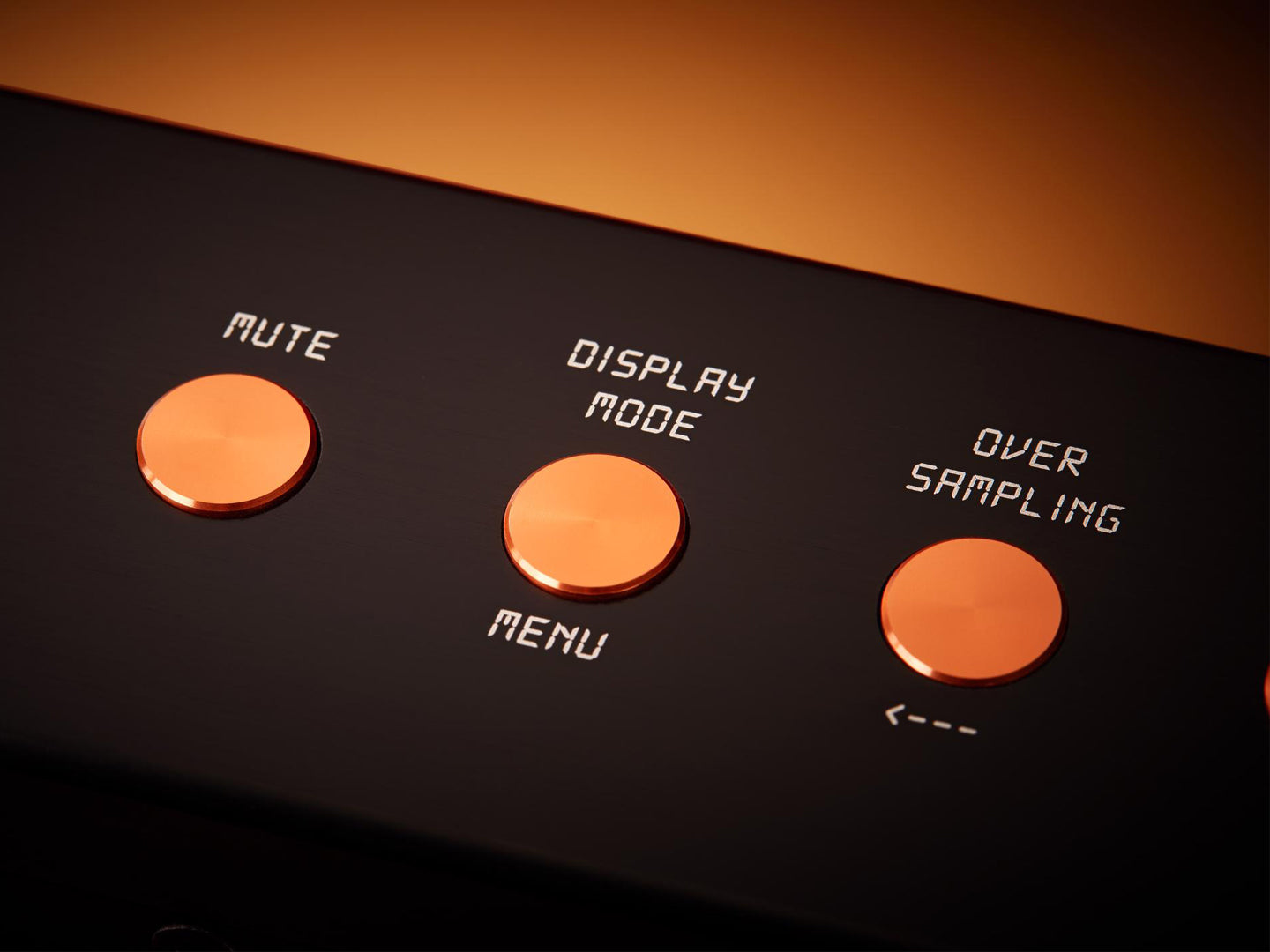
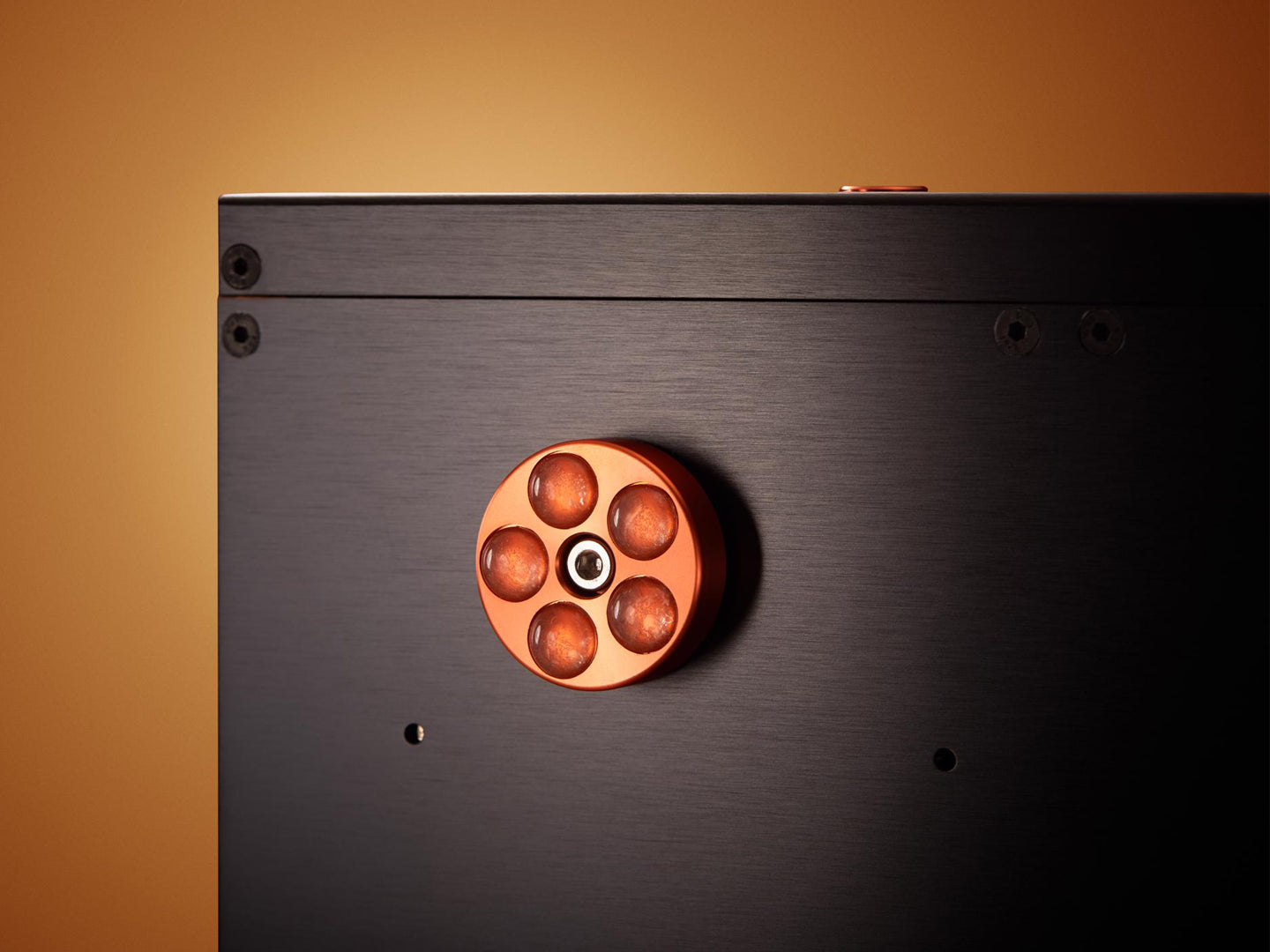
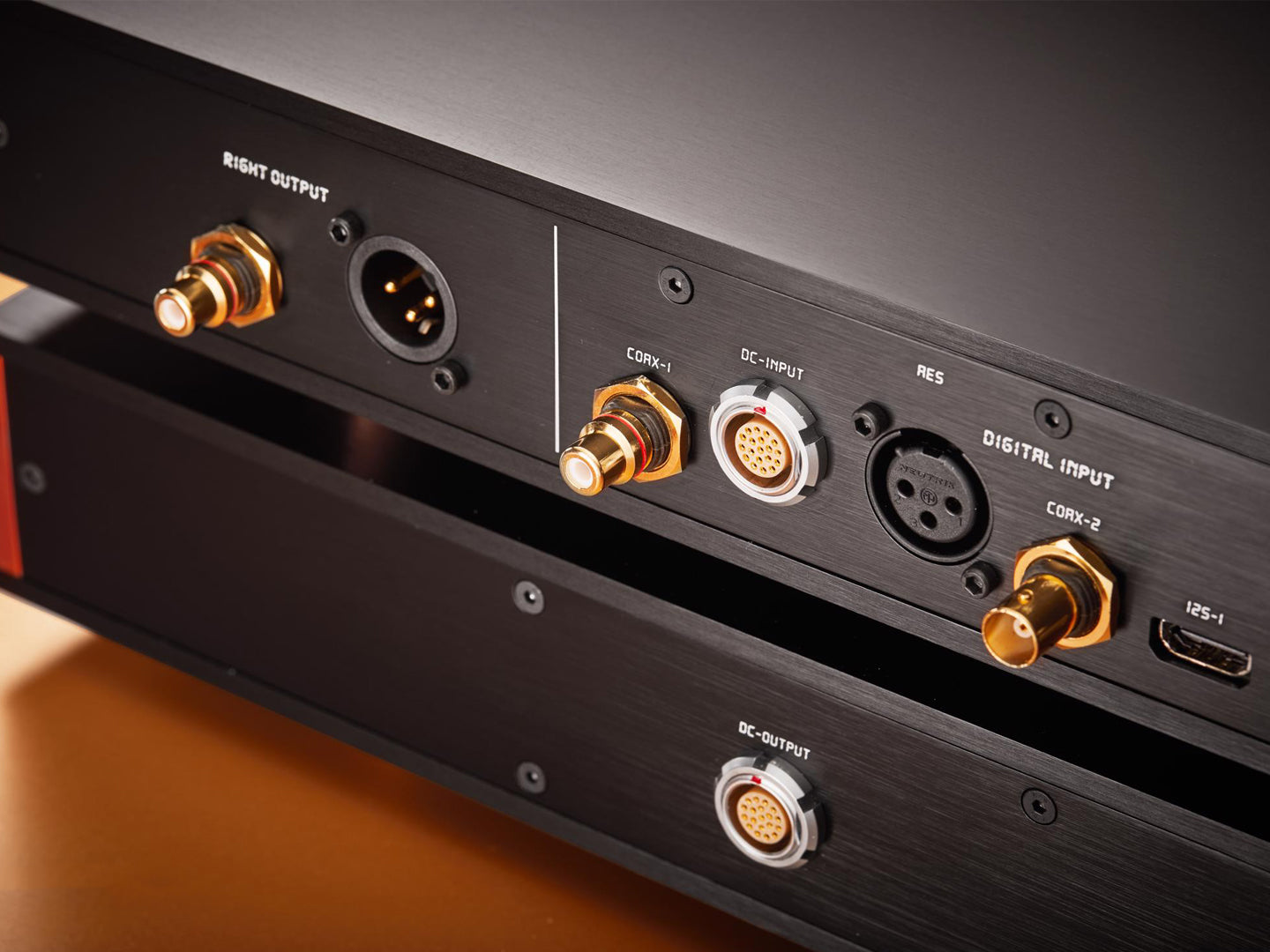
HoloAudio – May DAC
KTE May Specs:
- 100VA DUAL O-type(not Toroid) FLATWIRE (NOT roundwire) 6N Copper custom hand made audio transformers. (All models)
- All copper wire is replaced with 1.5mm pure OCC silver wire. Only KTE model
- Hand Selected DAC modules to have best measurements compared to averages. Higher dynamic range. Only KTE model.
- CNC Black/Copper shield DAC Module Covers on each module with laser etched KTE logos. Only KTE model.
- Replaced IEC inlet connectors with pure silver/rhodium plated faston connectors at the IEC inlet Only KTE model.
- Fuse is upgraded with world class Red Nano fuse with gold/silver and graphene and quartz filtering materials. Only KTE Model
- Standard Vishay caps are replaced/upgraded with KTE capacitors***
***unique ONLY to MAY KTE – KTE Caps to replace Vishay on the L1/L2 models (we have done extensive testing and these prove to provide intoxicating voicing and are beyond subtle improvements over L1/L2) - Custom made HoloAudio 1000V 1uF caps (replaces standard mundorf evo silver/gold caps)
- Enhanced USB module with Titanis 2.0 circuit
- Special Kitsune Tuned Edition branding inside and out (pure copper Kitsune fox emblem on top panel) + remote control / KitsuneHiFi VIP service, English support and manuals/software
Note: all models share/include same Flat wire O-type transformers, custom PLL with Crystek VCXO clocks, all copper and black chassis color, remote control, dc cable, ac cable. These are the shared features.
Estimated Time Before Shipping:


Description
May Dac = “The possibility of.”
The May DAC is here! over 3 years waiting and tremendous R&D to achieve a new level of performance and sound quality that sets a new standard. Ultimate endgame DAC. Natural Analog sound with no compromise. Having the best measurements of NOS R2R Dacs. And delivering our intoxicating sound signature that HoloAudio is known for.
This new DAC “May” is the design of a new generation, it’s HoloAudio’s finest technology all designed by Jeff Zhu, the engineer behind these great products. It’s a full discrete R2R type of audio decoder and does not have off the shelf-DAC chip! This is a bespoke custom-designed core DUAL MONO DAC modules that are truly a breakthrough with technology for any DAC chip today. The May is here to achieve new heights, new dynamics and simply a full spectrum of audio to please the aural senses.
You may be asking… well what is so special about this DAC? A Discrete R2R DAC with linear compensation…what is this?
There’s an additional R2R resistor network in the May DAC, that compensates the main R2R ladder. It works like trimming, but trimming is to change the resistor value. This additional R2R ladder is digitally controlled and will accurately compensate the resistor tolerance reaching a variance of 0.00005% tolerance accuracy. . For example, the MSB of 16 bits should have the value of 32768, but due to tolerance, it represents 32700 in real world results. Then that additional R2R ladder will compensate 68 into it. Thus it now becomes 32700 + 68 = 32768. What this means is that it’s likely the most precise Discrete DAC on the market with near flawless linearity, lowest THD and highest SNR of any NOS DAC. The sound is simply something you must experience to fully realize how special this DAC is. It’s a patented technology exclusive to HoloAudio. KitsuneHiFi is also HoloAudio USA and proud to bring you this DAC.
What are the May’s sound characteristics?
One of the strong points of the spring is the spatial sounds stage presentation. It’s very wide and precise. It never sounds congested like many DACs. The high end is very detailed and never harsh sounding. It has the R2R goodness that many have come to know and love. R2R has almost a cult like following and this DAC will surely become a sought after DAC. Everything comes effortlessly for this DAC. Bass is layered and textures, quite full and present without ever masking over the sweet mid tones that are produced. One special thing about the May is its amazing voltage regulation circuitry that better than 0.2uV output noise! This along with the FLATWIRO-core transformer helps regulate the purest power which translates to audio clarity and accurate reproduction. It must be heard to appreciate and come to love its sound. If you must have the best and nothing compromised then we would suggest the KTE or Kitsune Tuned Edition.
Kitsune HiFi
We carefully chooses products that we want to offer to our customers and be unique and/or stand out from all these audio supply stores. Jeff Zhu is a very talented engineer and is the brains behind HoloAudio. Some say he is the man behind the curtain and he has certainly impressed us with his knowledge and his newest line of products that surely will leave you impressed too!
The May DAC is the most recent product and is capable of DSD native on an Discrete Resister Ladder DAC! This May DAC is capable of DSD1024 native and actually running on his bespoke discrete ladder DAC! This is a unique custom build discrete resistor network DAC with linear compensation and advanced architecture based on R2R however we don’t refer to it as R2R since the design is far superior. This is our second discrete DAC that has linear compensation and this allows for ultimate music reproduction accuracy. Dual MONO R2R DAC Module resistor network with advanced architecture for PCM w/Linear Compensation. Also Dual Resistor Ladder network with optimized architecture specifically for DSD!
The KTE/Kitsune Tuned Edition is no longer just exclusive to us. We have licensed the build as being the ONLY authorized modded edition of the May DAC by HoloAudio. This means our authorized dealers will carry our KTE May! And if you buy from a dealer you will get support from that particular dealer. Many may continue to choose Kitsune HiFi and will receive our excellent customer service that we are well known for.
Jeff Zhu – HoloAudio – founder/engineer
Jeff Zhu is the man behind this engineering achievement. Below are some comments that have been shared by Jeff to better explain this DAC in his own words. HoloAudio is founded by Jeff Zhu and the USA division was a partnership formed with Tim Connor and his wife, Dawn Connor.
A note from Jeff:
Many have asked about how does a discrete resistor network accurately reproduce sound. This email is a good read for those who want a technical explanation on how Jeff was capable of achieving flawless linearity and ultra good specs on THD. This was a reply to a customer who had a technical question about resistors and their limitations.
“About the resistor tolerance, his word is partly right, but not accurate. The MSB of 16bits value only represent 32768, not 65536, all 16bits is 65535, but the MSB is only 32768. There are techniques to reduce this requirement. For example, segment+R2R, using segment into the first few bits, then r2r for the rest of them. Rockna is segment+R2R, TotalDAC is all R2R. And you can see, Rockna’s THD spec. is much better than Total. Total uses foil resistor, but they used the simplest architecture. That results an unsatisfied test performance. To my opinion, it’s some kind of wasting foil resistors. Soekris also uses segment+R2R. MSB’s old model is all R2R, but I don’t know about their new models.
Anyway, There are ways to improve the performance, the segment+R2R is one way. Trimming is another way. There is an additional R2R ladder in Spring, it compensate the main R2R ladder. It works like trimming, but trimming is to change the resistor value. This additional R2R ladder are digital controlled and is to compensate the resistor tolerance. For example, the MSB of 16 bits should have the value of 32768, but due to tolerance, it represent 32700 in real world. Then that additional R2R ladder will compensate 68 into it. Then it became 32700+68=32768.
Actually there are other ways to improve performance, I just told you two stories. There are more stories behind the design. It is really hard. I must count every via holes in layout, every PCB wire has it’s impedance and must put attention on it. A via hole can be 50 m Ohm, it is 1/20000 of 1 kilo-ohm, and you see, it covers 32768 which is the MSB of 16bits. Also the switches has self-impedance which is about several ohms to 30 ohms. If you find this issue. Maybe you will go crazy, it seems to be an impossible mission. But a good designer will overcome all these problems. It’s our value at HOLO Audio.
All the resistor tolerance, switch impedance, line impedance, via hole impedance, finally reflect as linearity. There is a chart that shows Spring’s linearity, it’s excellent. But I suggest you to look at THD performance. Bad linearity must result a bad THD performance. But good linearity doesn’t mean there will be good THD performance. THD is dynamic performance, more critical than linearity which is a static performance.
If you look at the THD performance, you will find Spring to maybe the best among those competitors. I’m applying a patent which contribute a lot of that performance. But I can’t tell you how. It’s confidential now.
Best Regards
Jeff Zhu”
And another note on Linear Compensation. As Some have asked what happens when the Resistors values change over time? Jeff responds:
No matter it is a digital switch or analog switch, they are built by transistors, can be either bjt, mosfet or jfet. They have self-impedance call Ron(impedance when at on state). If we expect a lower Ron, the a bigger transistor is needed. But bigger transistor has bigger self-capacitance that will cause switching speed to be lower. So there is no perfect components in the real world.
About long term drift, the modern resistor technology has made it much better than older process. But the most important thing is, we don’t care absolute drift, we only care relative drift. That means, if all resistors are drifted in the same direction and same speed. Then it will be no impact for this application. So, we make sure to use the same batch of components in a single board. That will minimize the problem causing by long term drift.
As I mentioned in the earlier email. Spring is not using trimming, but using compensation. Not matter it is trimming or compensation, their goal is same, to make the resistance much more accurate so the linearity and distortion can be improved a lot.
Best Regards
Jeff Zhu
Also, another customer asking about the oversampling, Jeff replied and has some good information to those who are curious.
The oversampling is done by AK4137, ‘OS PCM’ converts the input stream to PCM no matter it is PCM or DSD, then send to DAC. ‘OS DSD’ converts the input stream to DSD no matter is is PCM or DSD, then send to DAC. ‘OS’ over-samples the input stream. If it is DSD input, it over-sample to DSD256. If it is PCM input, it over-samples to PCM384K or 352.8K ‘NOS’ does no oversampling. send the input stream directly to DAC module. About DSD ‘native’, it is the way the USB transfer the stream. You know DOP, which is DSD Over PCM. DOP put the DSD into a PCM stream. At the receiver end, it just unpack the PCM stream and get the DSD back. DOP does NOT change any bit of DSD stream, just sending it with the package. So it waste some data rate. At the same data rate, DOP is 1/2 of DSD native, the other 1/2 is the package. So DOP and DSD native are all bit perfect. The DSD stream sending to DAC is all the same. So, now you should know, DSD native is just about the way it transfers the stream. Not describing the way it does digital to analog conversion. At the DAC stage, the DSD stream can convert to PCM then do the final digital to analog conversion. Actually, most DAC chips do this inside the chip. One point needs to be remembered, DSD streams can’t do volume attenuation. If this chip can do digital volume control under DSD mode, then is must converted to PCM already. Let’s go back to Spring. If Spring works in ‘NOS’ mode. There is no oversampling, no conversion, just the original data doing the final digital to analog conversion. I will not explain how it does PCM conversion, you should already know quite well about it. There is a lot of resistor ladder DAC, they are born to do this. I just explain how Spring can do ‘discrete DSD conversion’. Actually it is like DCS and CHORD. If you are looking to DCS and CHORD’s PCB, you will find ‘discrete DSD conversion’ is also using switches and precision resistors, like resistor ladder DACs. So, no matter
it is ‘discrete DSD conversion’ or ‘discrete PCM conversion’, they all use the same discrete devices. Just work in different architecture. That makes possible to combine these two modes in one device.
Best Regards
Jeff Zhu















KTE Specifications

Specifications
May DAC
Additional info
